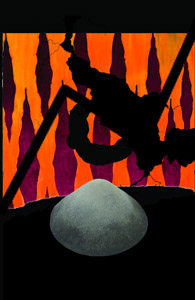 The first side of this cassette leads off in a realm closer to noise than anything of a more musical approach: thin, flaky distortion obscures deep, bellowing tones that are not necessarily dissonant, but not inviting either. Through this a churning, distorted rhythmic passage sneaks to the surface, bringing with it a bit of melody, albeit barely perceptible amidst the abstraction that surrounds it.
The first side of this cassette leads off in a realm closer to noise than anything of a more musical approach: thin, flaky distortion obscures deep, bellowing tones that are not necessarily dissonant, but not inviting either. Through this a churning, distorted rhythmic passage sneaks to the surface, bringing with it a bit of melody, albeit barely perceptible amidst the abstraction that surrounds it.
The UK’s Rejections, a relatively new project, has a consistent undercurrent of subverting more conventional, beat oriented electronic material.Although on this album they have stretched that abstraction even further, with most of these sidelong pieces keeping away from any overt rhythms and instead sneaking them in below layers of noise or other detritus.
Throughout the first side, there is a constant sense of movement as the piece moves from part to part and segment to segment. Submerged swells clash with sustained, shimmering electronics and an almost marching band like rhythm all make appearances in the half hour work.At times textural and meditative, and other times made up of blasting, ugly harsh bits of noise, the piece never stays still, but there is a logical and composed flow from one moment to the next.
The flip side of the tape is a little more constant in its approach, and its simple, reverberated drum machine opener is a bit reminiscent of the recent Clones EP from the project, which stayed closer to the traditional signifiers of techno music.Even when the overt beat drops out, the rhythm continues via more abstract loops and layers, even when it finally devolves into actual noise it ends up coming back around to a more musical close via a slowly pulsing bass synth passage.
While I enjoyed the more minimal techno orientation of Clones, here I favor the less traditional, more collage-like first half that eschews the obvious rhythms for more insinuated ones.It is a wonderful example of how something can be messy and tactile, yet still have a well developed sense of rhythm and structure, no matter how hidden it may be.The more rhythmic second half is no slouch either, but stands out as less unique and powerful in comparison.
samples:
 
Read More

